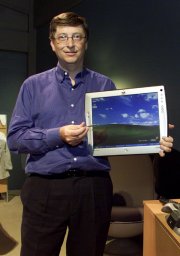Hey do you remember "Microsoft Mira?" No. What about "She Spies?"

Before there were even rumors of an Apple tablet, Microsoft had already unveiled their ill-fated Mira concept. Microsoft, in a stunning branding move, renamed the friendly sounding "Mira" to "Windows Powered Smart Display," good one guys. Anyways, a Windows Powered Smart display is a tablet display that wirelessly connects to a host Windows PC, allowing the user to access the computer from anywhere in the house, up to about 100 feet away. The idea seemed good enough, as ideally the Smart Display would be cheaper than a laptop, offer many of the same functionality without having to upkeep another computer. However, the execution was so abysmal that it never stood a chance.
Read on for more about why Mira failed.
Mira's failure can be attributed to just a handful of problems. For one, the displays were NOT less expensive than a cheap laptop. At the time of the launch all the "Smart Displays" hovered around $1000-1200, much more than a cheap laptop. And while you might be thinking, "Sure, but a cheap laptop can compare to the preformance of a top of the line desktop, which the Smart Display could be connected to." You'd be right, except that when the device wasn't docked the refresh rate was so low that gaming and even watching full screen video wasn't possible.
As if that wasn't bad enough here was the real problem: even with a Smart Display only one user could use the computer at a time. One would think that the obvious benefit of such a device is that one person could sit down at the computer while ANOTHER person used the Smart Display from another room. Or potentially, several smart displays could all be connected to the same desktop like wireless terminals. But none of this was possible with the first iteration, and while concurrent users was an acknowledged problem they meant to address in version 2 the product was so badly bungled that it never made it that far.
If they had gotten it right the first time, it would have been interesting to see if the concept would catch-on with customers. But honestly, if things like file sharing, printer sharing and virus protection were easier on a Windows PC these "Smart Displays" would really offer no benefits over an inexpensive laptop. So perhaps Microsoft abandoned the project to focus on those issues directly, maybe they'll get to it after Vista...
Related links
- Pen Computing - Mira
- Microsoft Windows Powered Smart Display Home
- Smart Displays still for sale, still too expensive
- She Spies
(And, Yes, I did choose She Spies because it ran for about the same time that Mira did.)